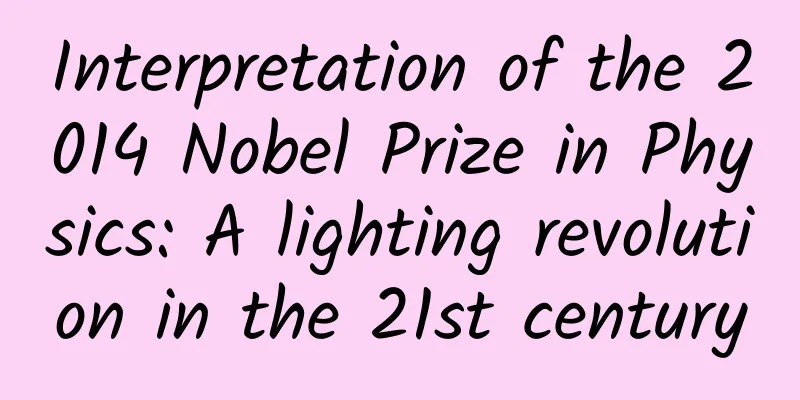Interpretation of the 2014 Nobel Prize in Physics: A lighting revolution in the 21st century

|
On October 7, 2014, Beijing time, the Nobel Prize in Physics was announced. Two Japanese scientists and one Japanese-American scientist shared the 2014 Nobel Prize in Physics. They are Isamu Akasaki and Hiroshi Amano, scientists from Nagoya University in Japan, and Shuji Nakamura, a Japanese-American scientist who was employed by Nichia Chemicals and the University of California, Santa Barbara. It can be seen from the company Nichia Chemical that this year's Nobel Prize in Physics is related to light emitting diodes. Nichia Chemical is a company located in Tokushima City in the northeastern part of Shikoku region of Japan. It mainly develops new high-efficiency and energy-saving LED lamps. The research direction of these three scientists is blue light emitting diodes, aiming to enable all mankind to use more energy-saving LED lamps. Compared with traditional artificial light sources, LED lights require less energy to achieve the same effect. Highly efficient and energy-saving LED lights help save the earth's resources. Blue LEDs are an environmentally friendly light source. Japanese scientists believe that the 21st century belongs to the world of LED lights, while the 20th century belonged to incandescent bulbs. In the past half century or so, red and green LEDs have been widely used in developed countries and regions such as North America, but blue LEDs are truly revolutionary lighting technology. Professionals around the world have been working on blue light-emitting diodes for decades. Although this research direction is high-risk, the rewards are also huge. We can take lighting technology to a new level. Therefore, it is natural to award the Nobel Prize in Physics to three scientists who have made outstanding contributions in this field. The winners of the Alfred Nobel Prize should lead the progress of human civilization. This technology allows us to have more efficient and lasting light sources. The working principle of light-emitting diodes. The upper left is the working principle of LED, and the lower one is the working principle of blue LED. Light-emitting diodes include multiple layers of semiconductor materials. According to the working principle of LED lamps, electricity is converted into photons, which is equivalent to improving the lighting efficiency compared with other light sources. Traditional lighting systems such as incandescent lamps will convert most of the electrical energy into heat and only a small amount into photons. Obviously, the conversion efficiency of such lighting systems is very low. Incandescent lamps and halogen lamps work on the principle of electric heating. When the current passes through the metal wire, it emits light, and a lot of energy is wasted in the electric heat. The principle of fluorescent lamps is different from that of incandescent lamps and halogen lamps. It generates light and heat through gas discharge, and its energy loss is less than that of incandescent lamps. Therefore, it is also called low-energy bulbs. However, after the advent of LED lamps, "low-energy bulbs" do not seem to belong to fluorescent lamps. The new LED lamp technology requires less energy and releases a more powerful light source, at least there will be a significant improvement in conversion rate. Nearly a quarter of the world's electricity consumption is used for lighting. If all high-efficiency and energy-saving LED lamps are used, the earth's resources can be saved, and the feedback on economic benefits is very obvious. LED lamps are not only durable, but also more efficient. Usually, the working life of incandescent lamps is 1,000 hours. After this time, the filament will be burned out, and the lighting time of fluorescent lamps is 10,000 hours, which is 10 times that of incandescent lamps. Then LED lamps have better durability and can reach 100,000 hours, thereby greatly reducing material loss. LED technology is not unfamiliar to us. It can be found in modern electronic devices such as mobile phones and computers. Red light-emitting diodes were developed in the late 1950s and used in digital watches, calculators and other devices. Many laboratories have tried to develop blue diodes with shorter wavelengths, but none of them have been successful. Akasaki Isamu and Amano Hiroshi's research direction is to develop materials in LED lighting systems. Through thousands of experiments, they found that gallium nitride performs very well on blue LED light sources and can be used to manufacture blue LED light sources. No one has been able to use gallium nitride crystals to manufacture high-quality LED light sources before. Shuji Nakamura of Nichia Chemical also chose gallium nitride crystals to replace zinc selenide as the basic material for blue LED light sources. In 1986, Isamu Akasaki and Hiroshi Amano completed the research and development of high-quality gallium nitride crystals for the first time. The preparation method was to coat aluminum nitride on a sapphire substrate to obtain high-quality gallium nitride. A few years later, they made another breakthrough in the research and development of the p-type layer of LED light sources. Through experiments with scanning electron microscopes, they found that this material had better luminous efficiency. In 1992, they were able to produce diodes that emitted dazzling blue light. Shuji Nakamura's research and development journey was also around 1988. He also successfully produced high-quality gallium nitride. In the 1990s, the two research groups further improved the lighting efficiency of blue LED light sources and invented a blue laser to cut a sharper beam of light. Because the wavelength of blue light is short, more information can be stored in the same area, thereby creating more powerful laser printers, LCD TVs, computers, mobile phones, etc. It is foreseeable that the advancement of blue LED technology will be a revolution in the field of lighting in the 21st century. In the future, we will use this technology to produce light sources close to natural light, which is conducive to the regulation of our biological clocks. Therefore, this technology can be used for greenhouse cultivation and even future settlements on Mars. Artificial light sources simulating natural light can allow astronauts to enter deeper space. For residents on Earth, cheaper and more efficient LED lights can allow more people to get lighting, because there are still 1.5 billion people living in areas on Earth that are not covered by the power grid. This shows that the research results of these three scientists have made a huge contribution to human civilization. As a winner of Toutiao's Qingyun Plan and Baijiahao's Bai+ Plan, the 2019 Baidu Digital Author of the Year, the Baijiahao's Most Popular Author in the Technology Field, the 2019 Sogou Technology and Culture Author, and the 2021 Baijiahao Quarterly Influential Creator, he has won many awards, including the 2013 Sohu Best Industry Media Person, the 2015 China New Media Entrepreneurship Competition Beijing Third Place, the 2015 Guangmang Experience Award, the 2015 China New Media Entrepreneurship Competition Finals Third Place, and the 2018 Baidu Dynamic Annual Powerful Celebrity. |
<<: Why do technology companies want to “slim down”?
>>: iPad air 2 is coming: is the gravedigger of notebooks coming?
Recommend
Why are cats the only ones among the cat family that become human pets?
I believe that many cat owners would think that c...
The Heavenly Palace selected the twelve zodiac animals. The one who overslept was not the cat, but...
In Chinese folklore, there is a story that is wel...
Startup products: How to scale up offline?
Recently, I have been learning how startups can s...
Case! “User incentive” routine fails? See how others do it
Now that you have users, what next? In the past t...
The Secret to Script Writing for Millions of Videos
TikTok short video sales have become a new force ...
What is Encyclopedia Promotion? How to do Encyclopedia Promotion?
With the continuous development of the Internet, ...
Baidu vocational education and training industry advertising promotion case
This article shares with you Baidu’s advertising ...
25 tips for Tik Tok operation and promotion!
As an Internet person who has been engaged in con...
Volkswagen POLO will launch 1.5L model, 1.4L will also be discontinued
Recently, the Volkswagen POLO 1.5L model applicat...
Property and Casualty Insurance Comprehensive Insurance: Unlocking New Ways to Increase Search Engine Optimization Indexing
I believe that many webmasters think that origina...
Dapeng Education-【Chinese Painting Academy】0904 Flower and Bird Special Enhancement Course
Dapeng Education - [Chinese Painting Academy] 090...
Where does the human tissue removed during surgery go?
【Written at the end】 For most people, the most li...
Apple iOS 14 is released today! These features you never thought of are all worth trying
June 23, early this morning, Apple held the WWDC2...
The most comprehensive summary of e-commerce operation and marketing terms!
The fastest way to understand an industry is to m...
China's smartphone shipments fell 6% in the second quarter, with Xiaomi's sales down 20% year-on-year
Market research company Canalys today released a ...









![[Popular Science of Chinese Military Technology] Why is it said that the reliability of ChatGPT in military applications needs to be verified?](/upload/images/67f22a94b88aa.webp)